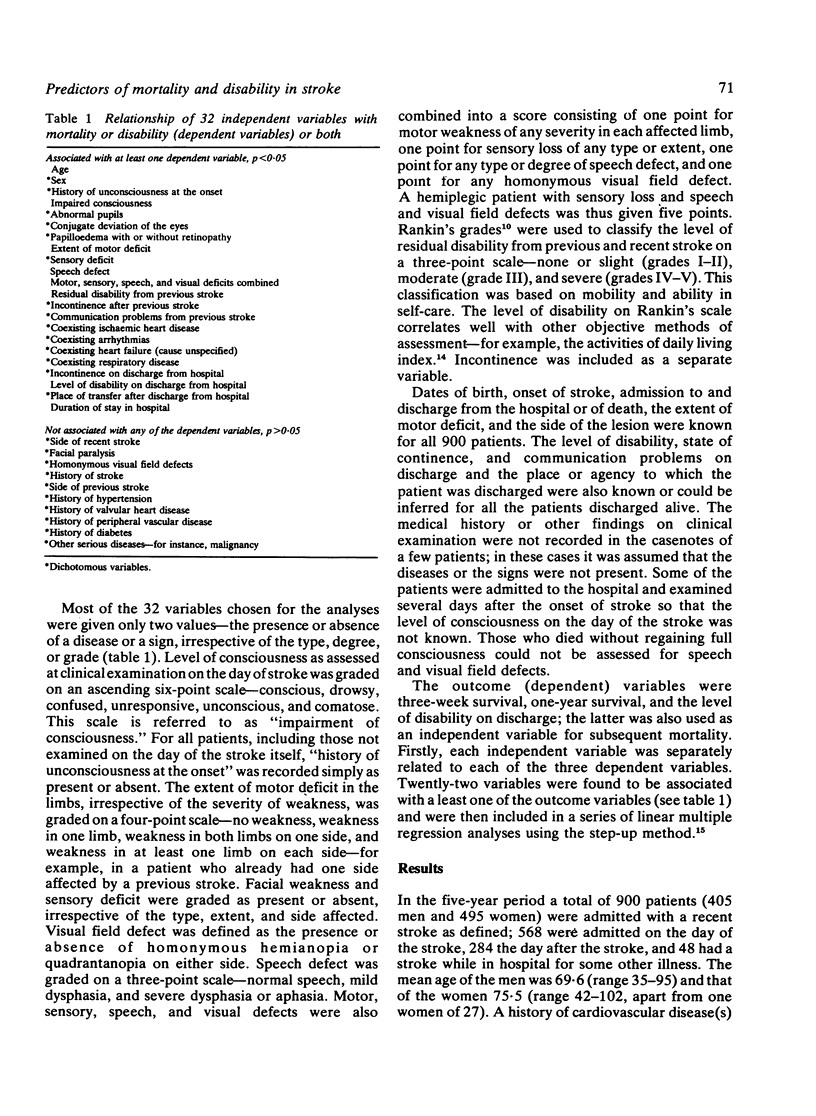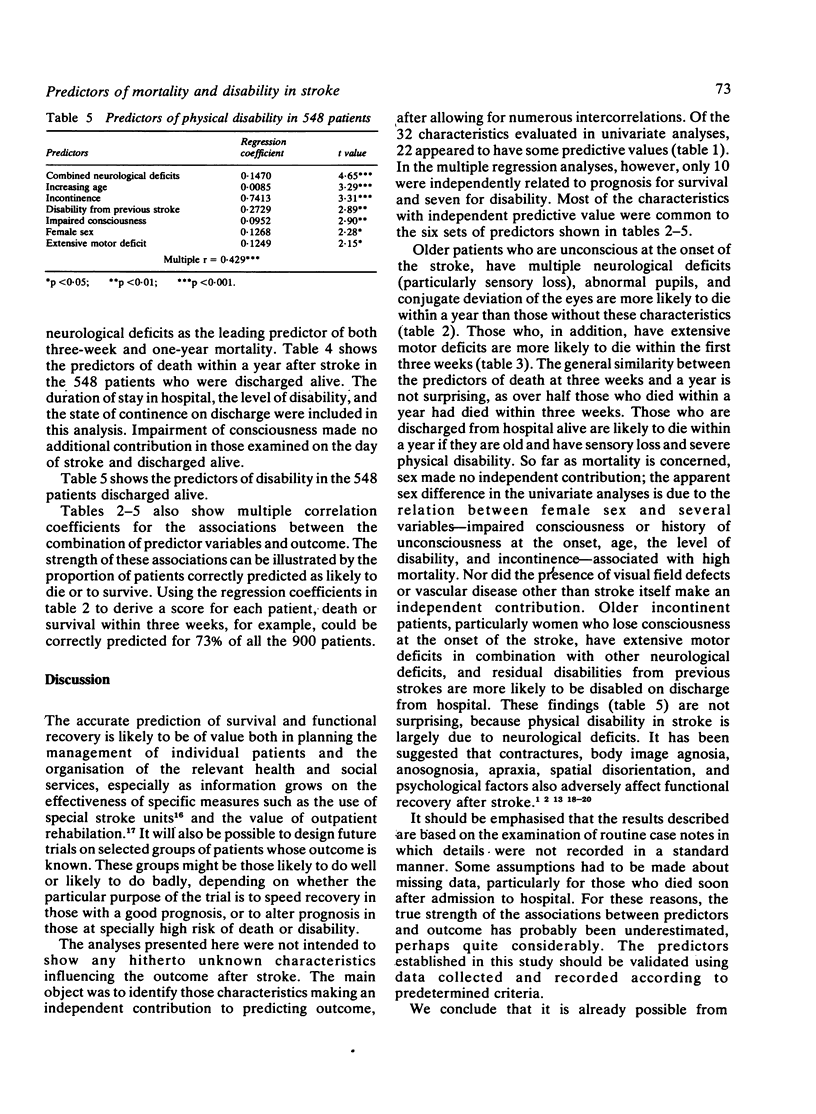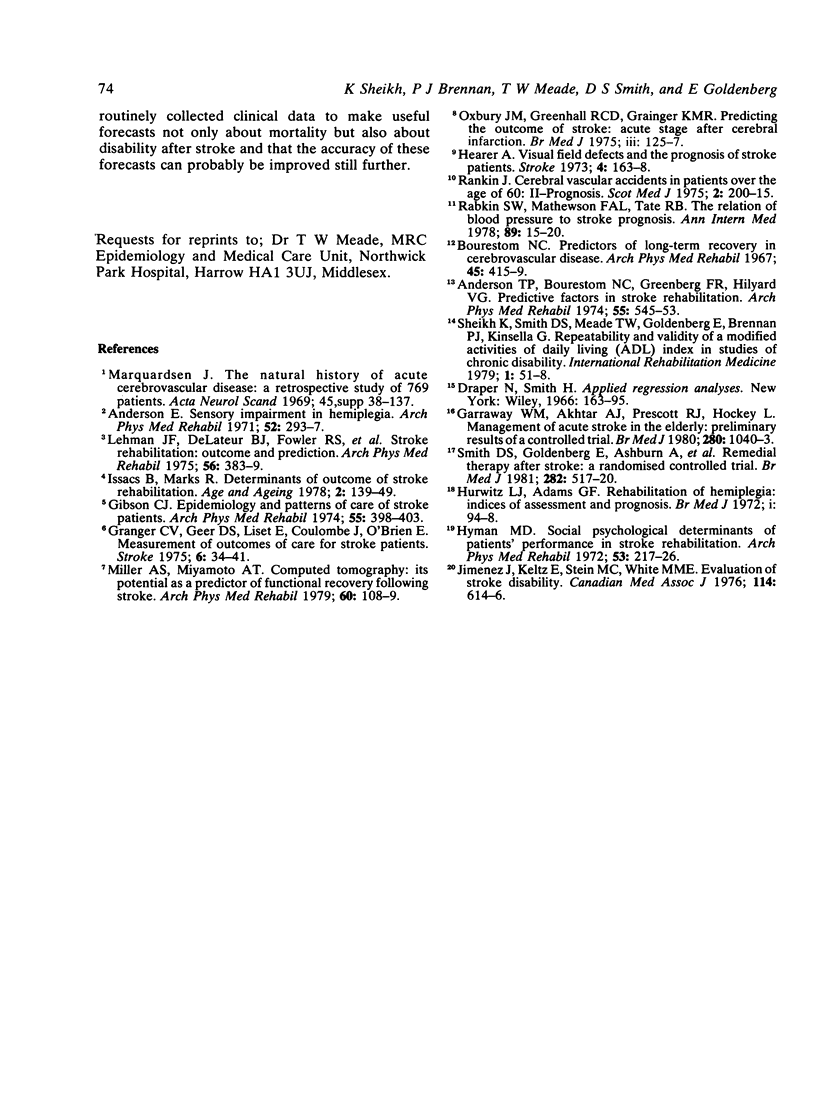Abstract
The increasingly accurate prediction of survival and functional recovery in patients with stroke will be of value in planning both their individual management and the health and social services needed. To establish the independent predictive effects of a range of personal and clinical characteristics, data on 900 patients admitted to Northwick Park Hospital with stroke were analysed by stepwise multiple regression. Older patients who lose consciousness at the outset and show signs of multiple neurological deficits, abnormal pupils, and conjugate deviation of the eyes are more likely to die within a year than those without these characteristics. Those who survive the acute episode and are discharged alive are more likely to die within a year if they are old and have sensory loss with severe physical disability. Older female patients who are incontinent, lose consciousness at the onset of stroke, sustain extensive motor deficits in combination with other neurological deficits, and have residual disabilities from previous strokes are particularly likely to be severely disabled on discharge from hospital. Routinely collected clinical data enable useful forecasts about mortality and disability after stroke. The accuracy of these forecasts can probably be improved further.
Full text
PDF




Selected References
These references are in PubMed. This may not be the complete list of references from this article.
- Anderson E. K. Sensory impairments in hemiplegia. Arch Phys Med Rehabil. 1971 Jul;52(7):293–297. [PubMed] [Google Scholar]
- Anderson T. P., Bourestom N., Greenberg F. R., Hildyard V. G. Predictive factors in stroke rehabilitation. Arch Phys Med Rehabil. 1974 Dec;55(12):545–553. [PubMed] [Google Scholar]
- Bourestom N. C. Predictors of long-term recovery in cerebrovascular disease. Arch Phys Med Rehabil. 1967 Aug;48(8):415–419. [PubMed] [Google Scholar]
- Garraway W. M., Akhtar A. J., Prescott R. J., Hockey L. Management of acute stroke in the elderly: preliminary results of a controlled trial. Br Med J. 1980 Apr 12;280(6220):1040–1043. doi: 10.1136/bmj.280.6220.1040. [DOI] [PMC free article] [PubMed] [Google Scholar]
- Gibson C. J. Epidemiology and patterns of care of stroke patients. Arch Phys Med Rehabil. 1974 Sep;55(9):398–403. [PubMed] [Google Scholar]
- Granger C. V., Greer D. S., Liset E., Coulombe J., O'Brien E. Measurement of outcomes of care for stroke patients. Stroke. 1975 Jan-Feb;6(1):34–41. doi: 10.1161/01.str.6.1.34. [DOI] [PubMed] [Google Scholar]
- Haerer A. F. Visual field defects and the prognosis of stroke patients. Stroke. 1973 Mar-Apr;4(2):163–168. doi: 10.1161/01.str.4.2.163. [DOI] [PubMed] [Google Scholar]
- Hurwitz L. J., Adams G. F. Rehabilitation of hemiplegia: indices of assessment and prognosis. Br Med J. 1972 Jan 8;1(5792):94–98. doi: 10.1136/bmj.1.5792.94. [DOI] [PMC free article] [PubMed] [Google Scholar]
- Hyman M. D. Social psychological determinants of patients' performance in stroke rehabilitation. Arch Phys Med Rehabil. 1972 May;53(5):217–226. [PubMed] [Google Scholar]
- Isaacs B., Marks R. Determinants of outcome of stroke rehabilitation. Age Ageing. 1973 Aug;2(3):139–149. doi: 10.1093/ageing/2.3.139. [DOI] [PubMed] [Google Scholar]
- Jimenez J., Keltz E., Stein M. C., White M. M. Evaluation of stroke disability. Can Med Assoc J. 1976 Apr 3;114(7):614–616. [PMC free article] [PubMed] [Google Scholar]
- Lehmann J. F., DeLateur B. J., Fowler R. S., Jr, Warren C. G., Arnhold R., Schertzer G., Hurka R., Whitmore J. J., Masock A. J., Chambers K. H. Stroke rehabilitation: Outcome and prediction. Arch Phys Med Rehabil. 1975 Sep;56(9):383–389. [PubMed] [Google Scholar]
- Miller L. S., Miyamoto A. T. Computed tomography: its potential as a predictor of functional recovery following stroke. Arch Phys Med Rehabil. 1979 Mar;60(3):108–109. [PubMed] [Google Scholar]
- Oxbury J. M., Greenhall R. C., Grainger K. M. Predicting the outcome of stroke: acute stage after cerebral infarction. Br Med J. 1975 Jul 19;3(5976):125–127. doi: 10.1136/bmj.3.5976.125. [DOI] [PMC free article] [PubMed] [Google Scholar]
- RANKIN J. Cerebral vascular accidents in patients over the age of 60. II. Prognosis. Scott Med J. 1957 May;2(5):200–215. doi: 10.1177/003693305700200504. [DOI] [PubMed] [Google Scholar]
- Rabkin S. W., Mathewson F. A., Tate R. B. The relation of blood pressure to stroke prognosis. Ann Intern Med. 1978 Jul;89(1):15–20. doi: 10.7326/0003-4819-89-1-15. [DOI] [PubMed] [Google Scholar]
- Sheikh K., Smith D. S., Meade T. W., Goldenberg E., Brennan P. J., Kinsella G. Repeatability and validity of a modified activities of daily living (ADL) index in studies of chronic disability. Int Rehabil Med. 1979;1(2):51–58. doi: 10.3109/03790797909164024. [DOI] [PubMed] [Google Scholar]
- Smith D. S., Goldenberg E., Ashburn A., Kinsella G., Sheikh K., Brennan P. J., Meade T. W., Zutshi D. W., Perry J. D., Reeback J. S. Remedial therapy after stroke: a randomised controlled trial. Br Med J (Clin Res Ed) 1981 Feb 14;282(6263):517–520. doi: 10.1136/bmj.282.6263.517. [DOI] [PMC free article] [PubMed] [Google Scholar]


